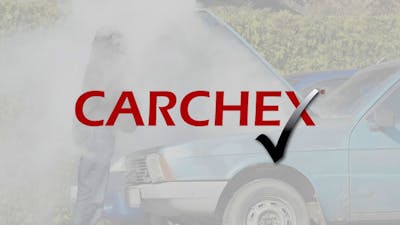How Much Does It Cost To Fix a Car’s Heat Shield?
One part commonly in need of repair on older vehicles is the heat shield. The good news for owners is that a heat shield is a repair that any mechanic can do, that you can likely do yourself, and it is not usually very costly. *Repair costs can range from under $50 to around $500 if a part is needed. *
Popular Warranty Providers
What is a Heat Shield?
Your vehicle has many parts that generate heat, so the heat must be managed. Heat shields are stamped metal parts that are placed over the hot sections of your vehicle. A small air gap helps insulate the hot parts. The heat shield's surface area is enough to dissipate the heat safely.
Why Does My Car Need a Heat Shield? What Does a Heat Shield Do?
Your vehicle’s engine, exhaust manifold, and emissions control system get hot enough to melt plastics, melt hoses, ignite grass and shrubbery you might park atop, and even cause damage to the interior of your vehicle. Automobile manufacturers use heat shields to prevent the heat from causing problems.
Some engine and exhaust systems work better when hot. Designers use heat shields to hold heat inside these sections. Your catalytic converter only does its job when hot. Your car has heat shielding around it, so you can make a few short trips and re-start the car with the converter piping hot and ready to reduce pollution.
Fun fact; Electric vehicles use heat shields around their batteries and powertrain components.
Why Did My Heat Shield Fail or Become Loose?
Stamped steel is a great material for making a heat shield in terms of heat dissipation. However, it is susceptible to corrosion. Automakers use various methods to try to prolong the life of heat shields, such as galvanization and zinc coatings.
In areas where roads are salted, the heat shield may have a shortened life as corrosion attacks any nicks, corners, and edges. Typically, heat shields rust near their fasteners, which are not the same exact type of metal. Dissimilar metals often cause localized rusting. Once the heat shield detaches from its fastening points, it can come loose.
What are the Symptoms of a Heat Shield Problem?
Buzzing from the engine compartment, a ringing sound below the car at idle, a gong-like sound over bumps, and general rattles are the symptoms of a loose heat shield. If your rear floors feel unusually hot or you can smell plastic melting in your engine bay, a heat shield may have gone AWOL.
Most vehicle owners find out they have a loose or missing heat shield when a mechanic does a multi-point inspection during an oil change, state safety inspection, or routine service visit.
Is it Better to Fix or Replace a Heat Shield?
If you discover that your car has a loose heat shield, it is imperative that you take action. It is far better to have a mechanic secure the loose heat shield than to wait for it actually to fall off and go missing. You can save considerable money by fixing rather than replacing a heat shield.
How Will a Mechanic Fix My Heat Shield?
Our image above shows how a mechanic might fix your heat shield. She will use a washer or a piece of metal to make a washer that can be used with a fastener to secure the heat shield back in place. As you can see from the image, the heat shield is rusting near the old fastener. Eventually, that rust will create a hole big enough for the heat shield to detach.
Experienced mechanics are geniuses in creating ways to affix a heat shield back in place. While not every fix will last the life of the vehicle, it is likely to last longer than the next failure point on the heat shield. It is not uncommon to have to repair heat shields more than once in a vehicle’s long life.
If the heat shield is severely degraded, or if it has fallen off and gone missing, the mechanic may have to obtain a replacement part. If a part is needed, the cost of the repair will be higher, of course.
Can I Just Remove My Heat Shield?
It is very tempting just to remove a hanging heat shield. Resist the urge! Your heat shield is either a safety device or part of your car’s emissions control system. Your car needs it. Will the car drive down the road after a heat shield is removed? Yes, it will, but you are taking a risk. A missing heat shield may also result in a failed state safety inspection if your state has one.
How Much Does It Cost To Fix a Heat Shield?
If the heat shield just needs to be reattached more securely, the cost to you will be almost all labor. So, your mechanic may charge you an hour of labor or however much is appropriate for the repair. In some cases adding a new fastener and large washer may suffice. If so, you will not be charged much. Our image above shows the cost a Boston-Area Subaru dealer charged us to secure a heat shield on a Toyota Highlander. The total cost was about $35.
If the heat shield has gone bye-bye or is so badly corroded it needs to be replaced, expect to pay more. This is the ideal type of repair in which to use a low-cost aftermarket part. If the exact part is not available, an experienced mechanic can often create one using heat-shield stock material.
Who Can Fix My Heat Shield?
Almost anyone who works on vehicles can fix a heat shield. An exhaust repair chain is a great place to try if you don't have a trusted local mechanic. Your dealer can certainly do the work, but you should expect to pay more if you take that path.
Can I Fix a Heat Shield Myself?
If you are an aspiring backyard mechanic, securing a heat shield is a great DIY project. On a scale where 1 is replacing a cabin air filter, and 5 is replacing an engine, fixing a heat shield is a 2. It helps to have ramps or a lift to do this type of work. There are helpful YouTube videos that show how heat shield repairs are performed. Do we have to mention that this is a job best performed when the car is cold and that eye protection is a must?
Is My Heat Shield Covered By My Extended Warranty?
Call us cynical, but this is the type of nebulous repair that many inclusive extended warranties are likely to exclude. The good news is that fixing a heat shield may well cost less than the deductible on an extended warranty. If the part is missing and must be replaced, it is certainly worth trying to use your extended warranty to cover repair costs.
Read more on the subject of Owning a Car here.





















